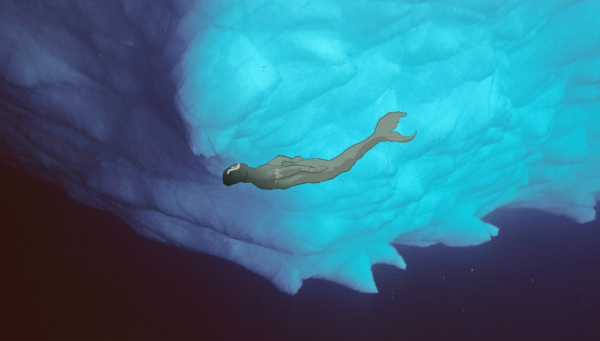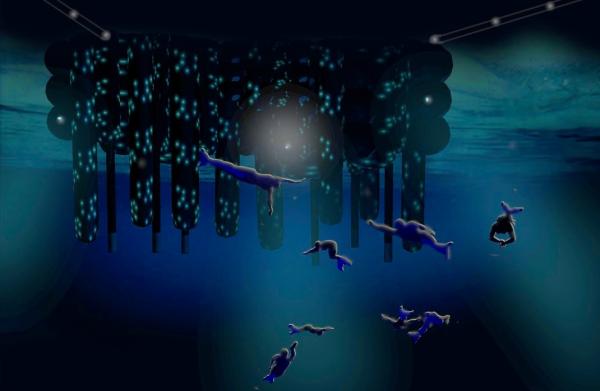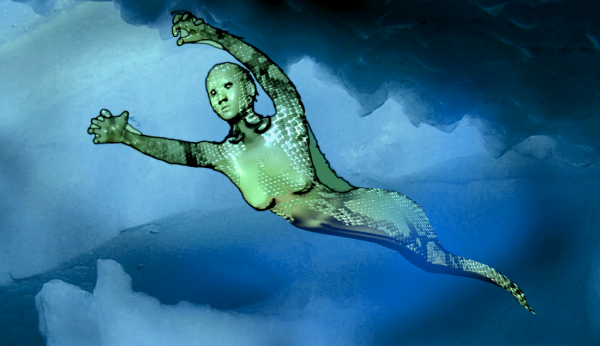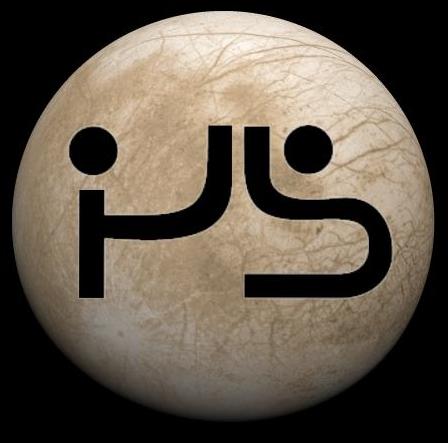BY LETTER
Europans
Highly derived aquatic tweak race, Sol System, 1st millennium A.T. to present. | |
 Image from Arik and The Architect | |
| Europan clades are fully aquatic, capable of breathing underwater | |
"As the freezing water got to his knees, a screen inside the water-proof control panel— set on the white metallic wall in front of him — burst to life. The unstable, distorted image on the screen showed something floating in the ocean outside the airlock, under the spotlight. The creature wasn't wearing any suit. It looked like a new kind of Europan tweak. But regular Europan tweaks would never leave the city or the research stations they worked with. And this seemed to be a more advanced biodesign, an engineered hybrid humanoid, obviously spliced at the genetic level: a human torso seamlessly flowing into a fishlike body with dorsal and ventral fins, ending in a coiling snake tail. Its human arms possessed hands with opposable thumbs, and supported fins that seemed to retract at will like handfans. Judging by its facial features, Odys
assumed the creature was a male. Just below the tweak floated some kind of fish, about the same size as him, apparently possessing a hard shell and powerful-looking fins. The tweak was holding a large kelp leaf on which a message glowed in blue bioluminescent letters:
"EUROPAN EMERGENCY SUIT" -Snapshot from "Ocean Untamed 627 AT"
Europanthropus aquaticus
The Jupiter moon Europa was a veritable treasure of ice and volatiles, and together with the other ice mines of the jovian moons it was one of the economic cornerstones of the Gengineer Republic. Water ice could be accelerated cheaply using the Oberth Effect, and exported to customers across the Solar System. But the Gengineer Republic began to raise their prices in the 4th century AT, causing a major problem for orbitals in the Inner Solar System who were forced to pay exorbitant fees for their water.At the same time many of the tweaks of the Republic found Europa somewhat lacking. The inner ocean predicted in the 1st century AT existed, but was quite lifeless (excluding the remnants of the 383 hoax perpetrated by White Fraction geneticists). Many believed Europa ought to be colonised and if not terraformed at least ecopoiesed.
In 495 AT, after having settled voluntary groups of merpeople from Earth and coming to the conclusion that they would never be able to live outside of their fully protected habitat, Jovian Genetics & Adaptation began the process of developing an integrated Europan ecosystem and humanoids adapted to a life in the dark, salty, high-pressure seas of Europa. The design was ambitious: a fully aquatic human, equipped to deal with low temperatures and extreme pressures as well as the anoxic chemical environment of Europa. The undersea biospheres of JGA developed a tweak form with a thick black skin covered with chromophores for signaling and sensitive to vibration. Legs were removed in favor of a flexible swimming tail, while the head was streamlined. The result was a being not unlike that could be described roughly as a deep sea man-shark. The largest changes were metabolic. JGA found that it was very hard to maintain a human-temperature metabolism in the Europan environment, and eventually settled for a radical redesign that made the Europans cold-blooded. Compared to ordinary humans they were sluggish, at least when in cold water, but as they warmed up due to the environment or exertion they accelerated and could for brief periods easily outspeed a baseline human.
 Image from Steve Bowers | |
| The Chandelier city of Atlantis, beneath the ice of Europa | |
Poseido managed an entire ecosystem, including medicinal plants, corals that grew under control into full mansions, recycler species, especially of microbes, and also various species of large deep-sea behemoths. Poseido also organized the Europans into a hive society and used them as safe proxies, immune to infection. Eventually, in 627 AT Poseido decided to plot the destruction of the shaft linking Atlantis (the undersea city, hanging downwards from the ice) to Alagonia (the surface capital city). Atlantis was completely evacuated, except for a few merpeople still living in pressurized habitats. After that, the Europan civilization experienced a golden age in complete isolation that was only mitigated by the scarcity of necessary chemical elements. Poseido managed to shift its consciousness to a biotechnological substrate, but found itself unable to progress on the toposophic scale and remained at S:1 level up until Europa was contacted by S:2 level transapients from the newly-formed First Federation.
 Image from Steve Bowers | |
| A snake-tailed Europan variant clade | |
Europan biotechnology also proved to be useful, especially since it circumvented many of the Federation regulations on replicating technology by being a "traditional and indigenous technology". Since controlling and managing it required much experience, skilled bioshamans were in high demand throughout the 1000-1100s (eventually more streamlined forms of biotechnology and nanotech superseded the old Europa technology, but "Europan-style" biotech retains an air of antique quaintness that tends to be revived around every five centuries or so in the Inner Sphere).
In the end, the Europans dispersed across human space, clading into many deep ocean aquatic lines. Especially well-known are the Iri-Kakkak Clade of Poseidon and the Deep Mekelonites of Mekelon, who have extensive investments in relativist starships and exploration.
 Image from Anders Sandberg | |
| The glyph of Europan Nation. Note the almost literal adaptation of the original JGA corporation symbol | |
Related Articles
Appears in Topics
Development Notes
Text by Updated by The Architect 2020
from an original article by Anders Sandberg and M. Alan Kazlev
Initially published on 05 September 2000.
Page uploaded 5 September 2000, last modified 16 April 2007, snapshot added june 2020
from an original article by Anders Sandberg and M. Alan Kazlev
Initially published on 05 September 2000.
Page uploaded 5 September 2000, last modified 16 April 2007, snapshot added june 2020






